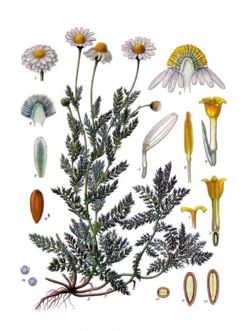Roman Chamomile
| subsp. var. | Roman Chamomile | |||||||||||||||||||||||||||||||||||||||||||||||||||||||
|---|---|---|---|---|---|---|---|---|---|---|---|---|---|---|---|---|---|---|---|---|---|---|---|---|---|---|---|---|---|---|---|---|---|---|---|---|---|---|---|---|---|---|---|---|---|---|---|---|---|---|---|---|---|---|---|---|

|
|
| ||||||||||||||||||||||||||||||||||||||||||||||||||||||
| ||||||||||||||||||||||||||||||||||||||||||||||||||||||||
| Standard Cyclopedia of Horticulture |
|---|
|
Anthemis nobilis, Linn. Chamomile. Half-spreading and much-branched herb, downy, the Lvs. very finely dissected: pappus wanting, chaff of the receptacle blunt. Var. grandiflora, Hort., is larger-fld. than the type, and sometimes yellow-fld.—A pleasant-scented herb, sometimes escaped from cult. It yields the medicinal chammile fls. of commerce. For medicinal purposes, the heads (the single preferred) are cut as soon as fully expanded, and dried. Cult, also as a hardy border plant; often double.
|
| Roman Chamomile {{{status}}} Fossil range: {{{fossil_range}}}
| ||||||||||||||||||||||||||||||||||||||||||||||||||||||||||||||||||
|---|---|---|---|---|---|---|---|---|---|---|---|---|---|---|---|---|---|---|---|---|---|---|---|---|---|---|---|---|---|---|---|---|---|---|---|---|---|---|---|---|---|---|---|---|---|---|---|---|---|---|---|---|---|---|---|---|---|---|---|---|---|---|---|---|---|---|
 Roman Chamomile | ||||||||||||||||||||||||||||||||||||||||||||||||||||||||||||||||||
| Plant Info | ||||||||||||||||||||||||||||||||||||||||||||||||||||||||||||||||||
| ||||||||||||||||||||||||||||||||||||||||||||||||||||||||||||||||||
| Scientific classification | ||||||||||||||||||||||||||||||||||||||||||||||||||||||||||||||||||
| ||||||||||||||||||||||||||||||||||||||||||||||||||||||||||||||||||
| [[{{{diversity_link}}}|Diversity]] | ||||||||||||||||||||||||||||||||||||||||||||||||||||||||||||||||||
| {{{diversity}}} | ||||||||||||||||||||||||||||||||||||||||||||||||||||||||||||||||||
| Binomial name | ||||||||||||||||||||||||||||||||||||||||||||||||||||||||||||||||||
| Anthemis nobilis | ||||||||||||||||||||||||||||||||||||||||||||||||||||||||||||||||||
| Trinomial name | ||||||||||||||||||||||||||||||||||||||||||||||||||||||||||||||||||
| {{{trinomial}}} | ||||||||||||||||||||||||||||||||||||||||||||||||||||||||||||||||||
| Type Species | ||||||||||||||||||||||||||||||||||||||||||||||||||||||||||||||||||
| {{{type_species}}} | ||||||||||||||||||||||||||||||||||||||||||||||||||||||||||||||||||
| {{{subdivision_ranks}}} | ||||||||||||||||||||||||||||||||||||||||||||||||||||||||||||||||||
| [[Image:{{{range_map}}}|{{{range_map_width}}}|]] | ||||||||||||||||||||||||||||||||||||||||||||||||||||||||||||||||||
| Synonyms | ||||||||||||||||||||||||||||||||||||||||||||||||||||||||||||||||||
| Chamaemelum nobile |
Anthemis nobilis, commonly known as Roman Camomile, Chamomile, garden camomile, ground apple, low chamomile, or whig plant, is a low European perennial plant found in dry fields and around gardens and cultivated grounds. The stem is procumbent, the leaves alternate, bipinnate, finely dissected, and downy to glabrous. The solitary, terminal flowerheads, rising 8 to twelve inches above the ground, consist of prominent yellow disk flowers and silver-white ray flowers. The flowering time is June and July, and its fragrance is sweet, crisp, fruity and herbaceous.
Chamomile is also used cosmetically, primarily to make a rinse for blonde hair, and is popular in aromatherapy, whose practitioners believe it to be a calming agent to end stress and aid in sleep.
Culture
The Chamomile is mentioned in Shakespeare's Henry IV, part 1 'The Camomile; The more it is trodden on, the faster it grows'.
Mary Wesley's novel The Camomile Lawn was also televised in Great Britain in the 1990s.
Folklore
Use of Chamomile dates back as far as ancient Egypt. Folk remedies using the plant include treatments for dropsy and jaundice. it was also believed to revive any wilting plant placed near it. The flowers were also used as a dye to lighten hair.
References
Howard, Michael. Traditional Folk Remedies (Century, 1987), p.112.